Ankle Joint Replacement
Ankle Joint Replacement
Ankle joint replacement surgery also known as total ankle arthroplasty (TAA) is a surgical treatment option for patients bothered by pain and loss of range of motion of their ankle joint. This procedure may be recommended if conservative treatment options such as bracing, medications, and injections have failed to alleviate your symptoms.
An ankle replacement is a reasonable option for an active older adult. For patients who want to keep their ankle motion for activities such as hiking, pickleball, swimming, biking, etc. It is not recommended to do repetitive, high-impact activities, such as running, after a total ankle replacement.
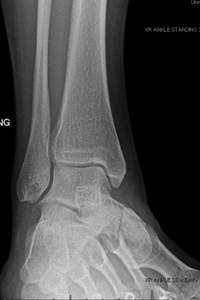 Normal
Ankle Joint Anatomy
Normal
Ankle Joint Anatomy
Three bones join to form the ankle joint. They include the shin bone or the tibia, the thinner bone going along the tibia known as the fibula, and the foot bone located above the heel bone known as the talus.
The bony protrusions seen and felt over the ankle joint are the malleoli. These include the medial malleolus which forms the base of the tibia and is felt on the inside of the ankle, the posterior malleolus which also forms the base of the tibia and is felt on the back of the ankle, and the lateral malleolus which is the low end of the fibula and is felt on the outside of the ankle.
The ankle joint allows up-and-down motion of the foot and the subtalar joint, located below the ankle joint, allows side-to-side motion of the foot. Bands of tough fibrous tissue known as ligaments surround the ankle joint and subtalar joints attaching the bones of the leg to each other and to the bones of the foot.
Causes
Arthritis is one of the major causes of ankle joint replacement. Arthritis is a general term covering numerous conditions where the joint surfaces wear out. The joint surface is covered by a smooth articular surface made of cartilage that allows pain-free movement in the joint. This surface can wear out for a number of reasons. Often the definite cause is unknown. When the articular cartilage wears out, the bone ends rub on one another causing pain.
In an arthritic ankle joint the cartilage lining is either thinner than normal or absent, the joint capsule is swollen, the joint space is narrowed, and bone spurs or excessive bone growth may occur at the edges of the joint.
Apart from arthritis, trauma (bone fractures), and infections can badly damage your ankle joint.
Diagnosis
A diagnosis can often be made by your foot and ankle orthopaedic surgeon by performing a medical history and physical examination along with imaging studies, such as radiographs, CT scans, and MRIs.
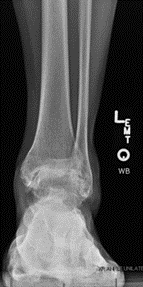
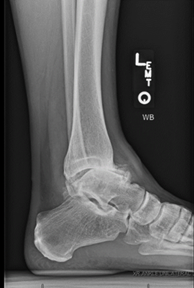
Surgical Procedure
Ankle joint replacement surgery is performed under sterile conditions in the operating room. It is often performed under general anesthesia, which means you will be asleep and will feel no pain throughout the procedure. Your surgeon will then make a small cut in front of your ankle and expose the ankle joint. Care will be taken to protect tissues and neurovascular structures and they will be pulled back from the site of the operation using retractors. Your surgeon will then use a bone saw to cut and remove damaged bone and cartilage from the tibia and talus.
Under the guidance of C-arm fluoroscopy (live-action x-rays), special surgical instruments are then used to cut the talus and tibia to precisely accommodate the new metal prostheses. The new metal parts of the artificial joint are then appropriately attached to the prepared bony surfaces of the talus and the tibia. Special glue or bone cement may be used to hold them in position. A plastic prosthesis is then inserted between the two metal parts. It acts like artificial cartilage and prevents the metal parts from rubbing against each other. The tendons and neurovascular structures are then positioned back to their normal anatomical position. In some cases, a plastic tube known as a drain will be placed in the surgical wound to drain any fluid. The surgical wound is then closed with sutures. Bandages are applied and the ankle is then immobilized using a splint, cast, or brace.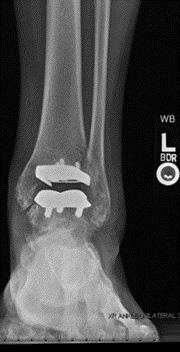
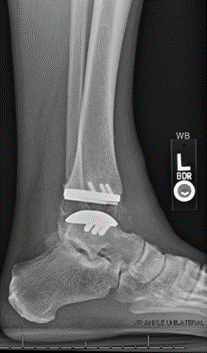
Post-Operative Care
- You will likely stay in the hospital for at least one night after your surgery. Your ankle will be in a splint when you wake up from surgery.
- You will be given pain medications to control your postoperative pain.
- The drain tube, if any, will be removed after 7-14 days.
- Your ankle will be elevated above the level of your heart and ice packs may be applied behind the knee to help reduce swelling and discomfort.
- Physical Therapy (PT) will begin 6-8 weeks after surgery.
- Sutures will usually be removed after 14-21 days.
- You will be instructed to keep your incision site clean and dry. You will be allowed to shower once the sutures are removed unless otherwise directed by your surgeon.
- Eating a healthy, balanced diet and not smoking will promote healing.
Advantages & Disadvantages
Most patients are benefited from the preservation of their existing range of motion after a successful ankle joint replacement surgery. The survival of this procedure depends on the wear of the artificial joint and revision surgery may be recommended in the future. Total ankle replacement may last for 10 or more years and the longevity depends on the extent of damage on the ankle joint before surgery, your overall health, and your activity levels.
Risks and Complications
Complications can be medical (general) or specific to ankle surgery. Medical complications include those of the anesthetic and your general well-being. Complications include:
- Allergic reactions to medications.
- Blood loss requiring transfusion.
- Formation of blood clots or deep vein thrombosis.
- Heart attacks, strokes, kidney failure, pneumonia, bladder infections.
- Complications from nerve blocks such as infection or nerve damage.
- Serious medical problems can lead to ongoing health concerns, prolonged hospitalization, or rarely death.
The majority of patients suffer no complications following ankle joint replacement, however, complications can occur following the surgery and include:
- Weakness, instability, or stiffness of the ankle.
- Loosening of the artificial components of the joint.
- Dislocation of the ankle joint.
- Fractures (break) of bones during the procedure.
- Infection or improper wound healing after surgery.
- Allergic reaction to the artificial joint.
- Failure to relieve pain.
A successful ankle joint replacement surgery can help alleviate or eliminate your ankle pain, preserve your existing ankle range of motion, and provide you with a greater quality of life.

